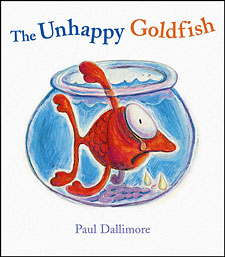One look at The Unhappy Goldfish told me that I had a winner on my hands when it came to my two young boys.
Every second Thursday my family makes its pilgrimage to the local library in our quest for "bed time' material. It's generally after 7pm and my four-year-old and two-year-old are clad in their pajamas, but there is no hint of sleepiness. Eyes " and mouths " wide open, they scan the shelves for picture books that fire their imagination. Paul Dallimore's artwork certainly has that eye-catching effect.
 The author/illustrator has used vivid crayons to assemble a cast that includes a miserable fish, a cute pup and a malevolent cat.
The author/illustrator has used vivid crayons to assemble a cast that includes a miserable fish, a cute pup and a malevolent cat.
The characters are well suited to an age group that enjoys mimicking the sounds for the various pets (everyone, including my two year old knows fish speak with "oh' " popping sounds), and the settings have enough depth to provide older children with details to identify. But the story provides one of the chief benefits for the under fives"
The central character of The Unhappy Goldfish has been made miserable by his isolation. He is ignored by the family that owns him and separated from any of his own kind by his tiny glass bowl. The arrival of a cute and highly favoured pup only seems to exacerbate his poignant situation.
However the moral seems to be that those who appear to be threats might actually be comrades in disguise, and just because someone is unlike us doesn't mean there is no basis for a friendship.
The Unhappy Goldfish could be well used by parents to help children adjust to a variety of situations, from the arrival of a new sibling to the separation anxiety that sometimes accompanies first days in new locations.
However, I think, from a Christian perspective, its most powerful use is as an illustration of grace.
Dallimore's pup enjoys the benefits of his status in the family, but he is happy to put them aside in the face of his watery friend's misery " even when the goldfish tries to rebuff his efforts. This canine friend doesn't seem to be motivated by anything other than the desire to see the goldfish returned to a state of happiness.
He provides the perfect cameo to develop Jesus' sacrificial character in little minds. And the warmth that flows from the book's final illustration well conveys the unexpected joy they can find in his friendship.

















